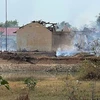Cambodia attracted 116.5 million USD in foreign direct investment (FDI) in the first two months of this year, showing a recovery in FDI attraction from a decrease of 46 percent to 5.9 billion USD last year.
The Cambodian Development Council (CDC) granted licences to nine projects worth 75 million USD in January and to six others worth 41.5 million USD in February.
The projects mainly involve in agriculture and apparel, including two garment and textile plants invested by China and Singapore , a Vietnamese-invested rice processing mill and several farm produce processing plants, according to the CDC.
The agriculture sector is becoming the most attractive area for foreign investors in the Kingdom and it has potential in the world market, especially in the European Union. The Cambodian government has offered various incentives for investments in the sector, including tax incentives, in order to turn agriculture into the country’s sustainable economic spearhead.
Cambodia has more than 6 million hectares under agricultural and industrial crops. However, only two-thirds of the acreage are under cultivated as the country lacks irrigation systems, advanced farming methods and high-yield strains.
With an output of about 7 million tonnes of rice in 2009, the government targets to produce about 8-9 million tonnes of rice by 2015, aiming to make rice a hard currency earner for the country./.
The Cambodian Development Council (CDC) granted licences to nine projects worth 75 million USD in January and to six others worth 41.5 million USD in February.
The projects mainly involve in agriculture and apparel, including two garment and textile plants invested by China and Singapore , a Vietnamese-invested rice processing mill and several farm produce processing plants, according to the CDC.
The agriculture sector is becoming the most attractive area for foreign investors in the Kingdom and it has potential in the world market, especially in the European Union. The Cambodian government has offered various incentives for investments in the sector, including tax incentives, in order to turn agriculture into the country’s sustainable economic spearhead.
Cambodia has more than 6 million hectares under agricultural and industrial crops. However, only two-thirds of the acreage are under cultivated as the country lacks irrigation systems, advanced farming methods and high-yield strains.
With an output of about 7 million tonnes of rice in 2009, the government targets to produce about 8-9 million tonnes of rice by 2015, aiming to make rice a hard currency earner for the country./.



















